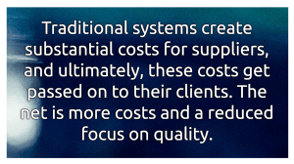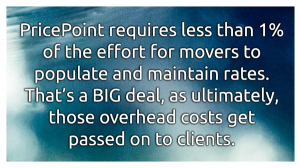Jul 2, 2018 Are You Aware of the Costs You Create for Your Suppliers?
By Ben Heller
While managing Accenture’s global mobility consulting practice, I evaluated many of the move pricing solutions out there. Some appeared as reverse e-Auction tools for ensuring competitive pricing on every move. Others were simple bid boards wrapped around an audit focus.

In conducting my due diligence, I determined that the costs for these types of solutions generally outweigh the benefits for the buyer. But what was really eye-opening was when I looked at the financial impact these solutions had on the moving partners. These systems create substantial costs for suppliers, and ultimately, these costs get passed on to their clients.
Where many move pricing systems fall short is on the overhead and expenses created by using these solutions. Movers often have to provide door-to-door pricing for many different weight and volumes with all potential costs and variables included in one price. That door to door pricing typically isn’t separated out by origin, destination, freight, and supplementals. This is challenging because while origin and destination pricing can remain the same for years, freight pricing changes all the time. Rather than just updating a freight rate, movers can be required to recalculate all the prices per lane again. Think of all the origins and destinations around the world… now you can see how filing 200,000 rates on a frequent basis is a reality for movers using these types of tools.
To make it even more challenging, some systems require all supplemental costs to be included in those rates. So movers must evaluate the risk frequency of crating, shuttles, and other services, then add in their expected average costs. This is hard to do. It asks movers to evaluate risk on a portfolio of clients where the supplemental requirements are likely to vary by client and location. The reality is that in these types of solutions, movers must accept that they will lose money on some moves. Even worse, these types of environments incentivize the mover NOT to provide the supplemental services required so their profits are not at risk. This inevitably decreases quality and increases claims.
All of this takes a tremendous amount of time and effort. And it’s not uncommon for large movers to have the added expense of multiple dedicated headcount where their primary responsibility is to populate rates into pricing systems. If this wasn’t already enough, many companies have a standard practice to conduct a post-shipment audit process on the movers. We’ve already pointed out the shortcomings of audits in our article “Household Goods Audits and Their Unintended Consequences”… the net is more costs and overhead put upon your moving partners who handle your business and a reduced focus on quality.
So how are we different?
- PricePoint was built to be mover friendly and solve movers’ pricing challenges. By breaking out the origin, destination, and freight pricing, movers can update those components independently and have the calculations performed by the system. This reduces the work associated with populating and managing rates tremendously. We did an analysis over the leading alternative and found that PricePoint requires less than 1% of the effort for movers to populate and maintain rates. That’s a BIG deal, as ultimately, those overhead costs get passed on to clients.
- Movers and freight forwarders can change their rates at any time. When a move is awarded in PricePoint, it’s linked to the movers pricing as of that date. That’s a big difference from environments that lock down rates for a year or more. In those environments, if a rate is too high, that’s not good because the client is paying too much or the mover may miss out on opportunities. If it’s too low, that’s not good either, as movers will need to squeeze out profitability somewhere else in the process, often to the detriment of the transferee.
- PricePoint empowers movers and freight forwards to connect to their partners’ pricing. Origin and destination agents can populate and share their pricing with whomever they want. It exponentially reduces the amount of work for your movers and forwarders. That equates to less work, lower costs, and always updated rates for everyone involved.
We haven’t been secretive about our goals here at PricePoint; we aim to simplify and streamline the buying and selling of moving. While many solutions have done the easy part already – simplifying the purchasing process for the buyer- they’ve ignored how their systems negatively affect the suppliers.
“How these systems impact your suppliers ultimately impacts you, and by choosing to work with a partner powered by PricePoint, you simplify and streamline the process for everyone.”
Want to learn more about how to make moving better, faster, and less expensive for you and your clients? Reach out to us at 
CEO Ben fell in love with the mobility industry while running Accentureʼs global mobility consulting practice. Focusing on the mobility supply chain, he learned the hard way that move pricing is complicated, unclear, and vulnerable to manipulation. After evaluating all existing alternatives, Ben partnered with Ryan to make data-driven moving decisions possible.


